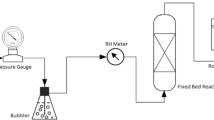Abstract
The present paper has dealt with the one-sidewall cooling effect of spherical adsorbent particles packed in a rectangular bed on water vapor adsorption characteristics by a 2-dimensional numerical analysis. The analysis model was considered that one-sidewall of a rectangular packed bed with homogeneous spherical silica gel particles was cooled and another walls were adiabatic. The moist air flowed into the rectangular adsorption bed packed with spherical adsorbent particles. Fuji Sylsia silica gel B was selected as a suitable adsorbent with high adsorption ability over high relative humidity. Numerical results revealed the effects of moist air inlet humidity, airflow velocity, size of spherical silica gel particles, width of the rectangular packed bed, and the side-wall cooling temperature on the amount of water vapor adsorption.
















Similar content being viewed by others
References
Andreas Hauer (2002) Thermal energy storage with zeolite for heating and cooling applications IEA, ECES IA Annex 17, Advanced thermal energy storage through phase change materials and chemical reactions-feasibility studies and demonstration projects. 3rd Workshop Tokyo Japan
Sakoda A; Suzuki M (1984) Fundamental study on solar powered adsorption cooling system. J Chem Eng Japan 17(1): 52–57
Saha BB; Kashiwagi T (1997) Experimental investigation of an advanced adsorption refrigeration cycle. ASHRAE Transactions: Res 103(2): 50–58
Saha BB; Akisawa A; Kashiwagi T (2001) Solar/Waste heat driven two-stage adsorption chiller: The Prototype. Renewable Energy 23: 93–101
Kunii D (1976) Netsuteki tanI sousa (I), Maruzen 123–159
Fraenkel D (1977) The potential of zeolite molecular sieves as hydrogen storage media alternative energy sources hemisphere publishing corporation washington DC 8: 3771–3802
Hanneke van de Ven (1999) Sorption heat pump systems - an international overview. IEA Heat Pump Centre Newletter 17(2): 10–12
Inaba H (1996) Refrigerant in JSRAE. 71(823): 3–11
Inaba H; Kida T; Horibe A; Kaneda M; Okamoto T; Seo JK (2000) Water vapor desorption characteristics of honeycomb type sorption element composed of organics sorbent. Trans JSRAE 17(3): 333–342
Inaba H (2002) The present state and development of adsorption type thermal system. Proceedings of 2002 JSRAE Annual Conference 573–576
Yanai H (1982) Kyutyakuzai ·Kyutyaku Sousano Sekkei, pp 142–186
Yanagi H (1999) R & D on adsorption cooling system in Japan IEA heat pump centre newletter 17(2): 13–14
Katoo F et al. (1979) Transactions of The JSME (series B) 45(400): 1825–1831
Alam KCA; Saha BB; Kang YT; Akisawa A; Kashiwagi T (2000) Heat exchanger design effect on the system performance of silica gel adsorption refrigeration systems. Int J Heat and Mass Transfer : 1–13
Yanadori M; Watabe Y (1998) Thermal characteristics of chemical refrigerating apparatus using silica-gel/inorganic-salt-solution pair. Trans JSRAE 15(1): 97–103
Biswas P; Kim S; Mills AF (1984) A compact low-pressure drop desiccant bed for solar air conditioning applications: analysis and design. Trans ASME J Solar Energy Engineering 106: 153–158
Bauer R; Schlünder EU (1978) Int Chem Eng 18(2): 189
Collier RK; Barlow RS; Arnold FH (1982) An overview of open-cycle desiccant-cooling systems and materials. Trans ASME J Solar Energy Eng 104: 28–34
Kuma T; Hirose T; Goto M; Kodama A (1998) Thermally regenerative monolithic rotor dehumidifier for adsorption cooling system. Trans ASME J Solar Energy Eng 120: 45–50
Hamamoto Y; Sato H; Saha BB; Akisawa A; Kashiwagi T (2000) Study on prediction models of amount of adsorbed water in silica gel packed beds. Trans JSRAE 17(3): 313–321
Hamamoto Y; Okajima J; Matsuoka F; Akisawa A; Kashiwagi T (2002) Performance analysis of rotary dehumidifier/humidifier and systems 1st report: theoretical model. Trans JSRAE 19(3): 281–292
Japan Industrial Standard (1992) JIS C9617 Humidifier
Author information
Authors and Affiliations
Corresponding author
Rights and permissions
About this article
Cite this article
Inaba, H., Seo, J.K. & Horibe, A. Numerical study on adsorption enhancement of rectangular adsorption bed. Heat Mass Transfer 41, 133–146 (2004). https://doi.org/10.1007/s00231-004-0512-x
Received:
Published:
Issue Date:
DOI: https://doi.org/10.1007/s00231-004-0512-x




